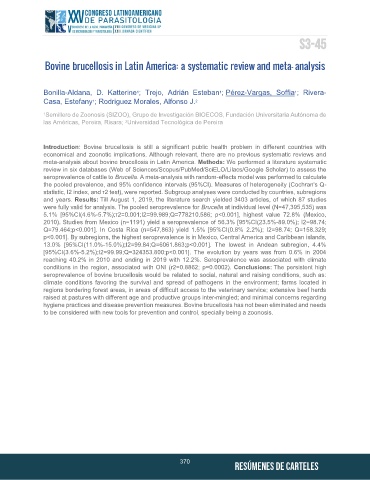Page 372 - Resúmen - XXV Congreso Latinoamericano de Parasitología - FLAP
P. 372
S3-45
Bovine brucellosis in Latin America: a systematic review and meta- analysis
Bonilla-Aldana, D. Katterine ; Trejo, Adrián Esteban ; Pérez-Vargas, Soffia ; Rivera-
1
1
1
Casa, Estefany ; Rodriguez Morales, Alfonso J.
2
1
1 Semillero de Zoonosis (SIZOO), Grupo de Investigación BIOECOS, Fundación Universitaria Autónoma de
las Américas, Pereira, Risara; Universidad Tecnológica de Pereira
2
Introduction: Bovine brucellosis is still a significant public health problem in different countries with
economical and zoonotic implications. Although relevant, there are no previous systematic reviews and
meta-analysis about bovine brucellosis in Latin America. Methods: We performed a literature systematic
review in six databases (Web of Sciences/Scopus/PubMed/SciELO/Lilacs/Google Scholar) to assess the
seroprevalence of cattle to Brucella. A meta-analysis with random-effects model was performed to calculate
the pooled prevalence, and 95% confidence intervals (95%CI). Measures of heterogeneity (Cochran's Q-
statistic, I2 index, and τ2 test), were reported. Subgroup analyses were conducted by countries, subregions
and years. Results: Till August 1, 2019, the literature search yielded 3403 articles, of which 87 studies
were fully valid for analysis. The pooled seroprevalence for Brucella at individual level (N=47,395,535) was
5.1% [95%CI(4.6%-5.7%);τ2=0.001;I2=99.989;Q=778210.586; p<0.001], highest value 72.8% (Mexico,
2010). Studies from Mexico (n=1191) yield a seroprevalence of 56.3% [95%CI(23.5%-89.0%); I2=98.74;
Q=79.464;p<0.001]. In Costa Rica (n=547,863) yield 1.5% [95%CI(0.8% 2.2%); I2=98.74; Q=158.329;
p<0.001]. By subregions, the highest seroprevalence is in Mexico, Central America and Caribbean islands,
13.0% [95%CI(11.0%-15.0%);I2=99.84;Q=6061.863;p<0.001]. The lowest in Andean subregion, 4.4%
[95%CI(3.6%-5.2%);I2=99.99;Q=324353.800;p<0.001]. The evolution by years was from 0.6% in 2004
reaching 40.2% in 2010 and ending in 2019 with 12.2%. Seroprevalence was associated with climate
conditions in the region, associated with ONI (r2=0.8862; p=0.0002). Conclusions: The persistent high
seroprevalence of bovine brucellosis would be related to social, natural and raising conditions, such as:
climate conditions favoring the survival and spread of pathogens in the environment; farms located in
regions bordering forest areas, in areas of difficult access to the veterinary service; extensive beef herds
raised at pastures with different age and productive groups inter-mingled; and minimal concerns regarding
hygiene practices and disease prevention measures. Bovine brucellosis has not been eliminated and needs
to be considered with new tools for prevention and control, specially being a zoonosis.
370
RESÚMENES DE CARTELES

